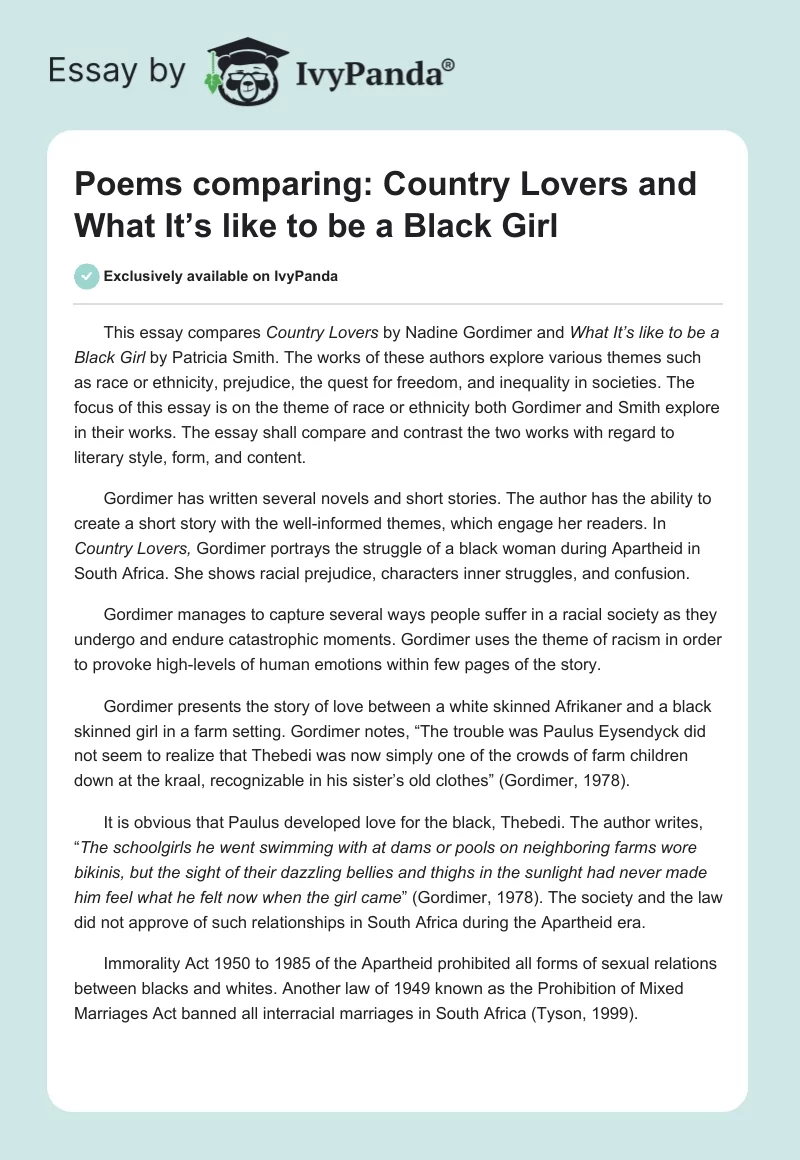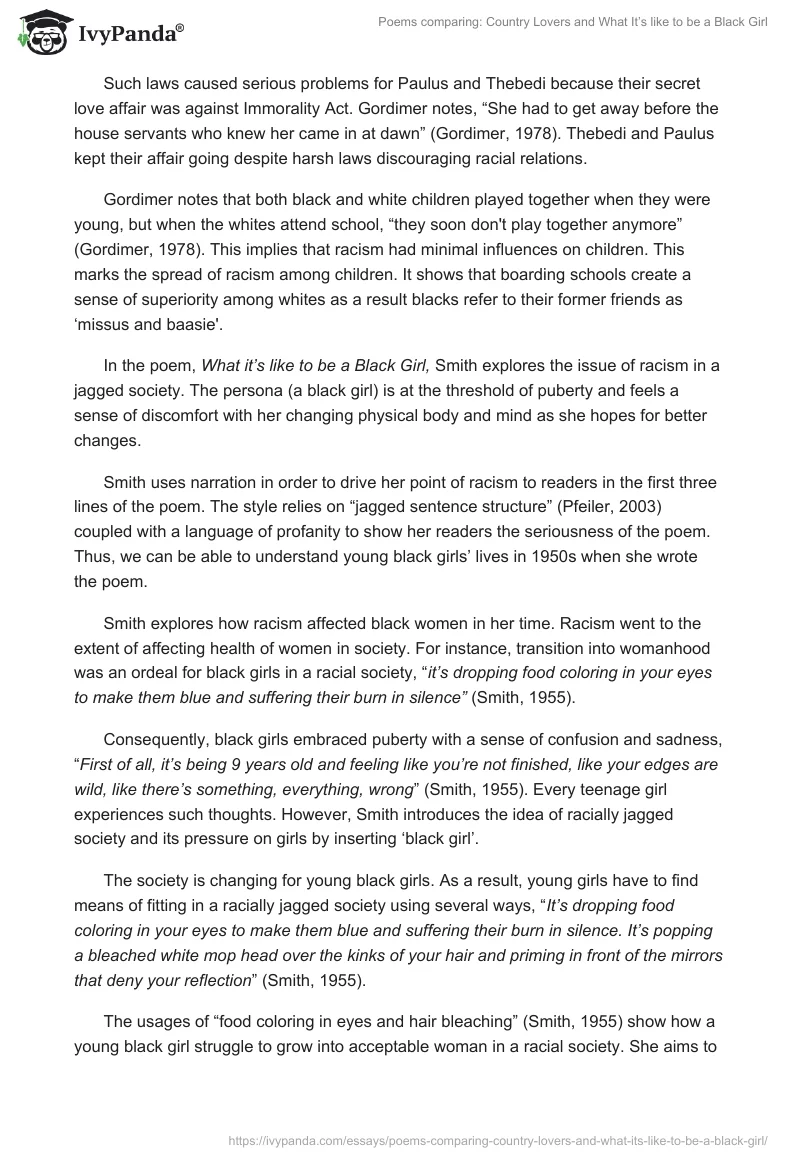This essay compares Country Lovers by Nadine Gordimer and What It’s like to be a Black Girl by Patricia Smith. The works of these authors explore various themes such as race or ethnicity, prejudice, the quest for freedom, and inequality in societies. The focus of this essay is on the theme of race or ethnicity both Gordimer and Smith explore in their works. The essay shall compare and contrast the two works with regard to literary style, form, and content.
Gordimer has written several novels and short stories. The author has the ability to create a short story with the well-informed themes, which engage her readers. In Country Lovers, Gordimer portrays the struggle of a black woman during Apartheid in South Africa. She shows racial prejudice, characters inner struggles, and confusion.
Gordimer manages to capture several ways people suffer in a racial society as they undergo and endure catastrophic moments. Gordimer uses the theme of racism in order to provoke high-levels of human emotions within few pages of the story.
Gordimer presents the story of love between a white skinned Afrikaner and a black skinned girl in a farm setting. Gordimer notes, “The trouble was Paulus Eysendyck did not seem to realize that Thebedi was now simply one of the crowds of farm children down at the kraal, recognizable in his sister’s old clothes” (Gordimer, 1978).
It is obvious that Paulus developed love for the black, Thebedi. The author writes, “The schoolgirls he went swimming with at dams or pools on neighboring farms wore bikinis, but the sight of their dazzling bellies and thighs in the sunlight had never made him feel what he felt now when the girl came” (Gordimer, 1978). The society and the law did not approve of such relationships in South Africa during the Apartheid era.
Immorality Act 1950 to 1985 of the Apartheid prohibited all forms of sexual relations between blacks and whites. Another law of 1949 known as the Prohibition of Mixed Marriages Act banned all interracial marriages in South Africa (Tyson, 1999).
Such laws caused serious problems for Paulus and Thebedi because their secret love affair was against Immorality Act. Gordimer notes, “She had to get away before the house servants who knew her came in at dawn” (Gordimer, 1978). Thebedi and Paulus kept their affair going despite harsh laws discouraging racial relations.
Gordimer notes that both black and white children played together when they were young, but when the whites attend school, “they soon don’t play together anymore” (Gordimer, 1978). This implies that racism had minimal influences on children. This marks the spread of racism among children. It shows that boarding schools create a sense of superiority among whites as a result blacks refer to their former friends as ‘missus and baasie’.
In the poem, What it’s like to be a Black Girl, Smith explores the issue of racism in a jagged society. The persona (a black girl) is at the threshold of puberty and feels a sense of discomfort with her changing physical body and mind as she hopes for better changes.
Smith uses narration in order to drive her point of racism to readers in the first three lines of the poem. The style relies on “jagged sentence structure” (Pfeiler, 2003) coupled with a language of profanity to show her readers the seriousness of the poem. Thus, we can be able to understand young black girls’ lives in 1950s when she wrote the poem.
Smith explores how racism affected black women in her time. Racism went to the extent of affecting health of women in society. For instance, transition into womanhood was an ordeal for black girls in a racial society, “it’s dropping food coloring in your eyes to make them blue and suffering their burn in silence” (Smith, 1955).
Consequently, black girls embraced puberty with a sense of confusion and sadness, “First of all, it’s being 9 years old and feeling like you’re not finished, like your edges are wild, like there’s something, everything, wrong” (Smith, 1955). Every teenage girl experiences such thoughts. However, Smith introduces the idea of racially jagged society and its pressure on girls by inserting ‘black girl’.
The society is changing for young black girls. As a result, young girls have to find means of fitting in a racially jagged society using several ways, “It’s dropping food coloring in your eyes to make them blue and suffering their burn in silence. It’s popping a bleached white mop head over the kinks of your hair and priming in front of the mirrors that deny your reflection” (Smith, 1955).
The usages of “food coloring in eyes and hair bleaching” (Smith, 1955) show how a young black girl struggle to grow into acceptable woman in a racial society. She aims to be like white women, who have white skin, blonde hair, and blue eyes and then men would admire.
Historical analysis requires readers’ knowledge of historical events of the time (Tyson, 1999). This enables readers to understand the form and context of literary works in the context of history. Therefore, we can understand both Country Lover and What It’s like to be a Black Girl in the context of history. Readers can only imagine what blacks experienced at the time of Apartheid and its effects on mixed raced relationships.
For instance, Gordimer notes, “He told her, each time, when they would meet again” because they cannot be seen in public together (Clugston, 2010). From the above sentence, we can understand why the relationship between Thebedi and Paulus was socially wrong. The Apartheid laws prohibited such relationships between mixed races. The white people controlled most aspects of social life in South Africa.
Their children attended best schools and learned ideas about racial segregation in society. On the other hand, blacks learned to respect white people as they grew up. Therefore, understanding the historical context of Country Lover enables readers to understand the position of a black woman when Paulus murdered the baby.
Both the poem and the short story have shown historical forms and settings. Gordimer and Smith wrote their works while racism was a dominant factor in a relationship between whites and black. Apartheid reflected racial discrimination in South Africa, whereas sense of skin color discrimination showed racial discrimination in American society.
Both works show that racism influenced all aspects of life, including individual appearances and interracial marriages. In the case of Thebedi, racism denied Thebedi justice following the murder of her child. Within the historical context, Gordimer aims to invoke social protest using her short story. She highlights and draws readers’ attention to contemporary social problems in South Africa as she hopes for change (Lazar, 1993).
On the other hand, the poem depicts a black girl struggling to fit in a racial society (Smith, 1955). Therefore, we can only understand lives of Black Americans during racial segregation and discrimination based on skin color. In the poem, we can relate to the struggle of a young black as she struggles to grow into an acceptable woman in a racial society (Pfeiler, 2003).
Smith uses the form of confessional poetry in which she explores intensely experiences of black women with unusual frankness. This was the case in 1950s when writers condemned social issues in society. Smith aims to bring readers’ attention to social pressure black women experience in order to gain acceptance in a racial society.
Smith also uses her poem as a form of social protest with the hope that social circumstances will improve as she notes, “it’s finally have a man reach out for you then caving in around his fingers” (Smith, 1955).
The contents of What It’s like to be a Black Girl and Country Lover have women to depict racism in societies as they deal with unfairness in societies as protagonists of the story. Both writers use black women because such acts affect them most in society.
Smith uses vocal style to express her feelings in the poem. This style of expression enables readers to understand that being a black woman in a racial society tough. The author uses words, which arouse a sense of sadness and indignation such as ‘everything wild’ and ‘suffering their burn in silence’. Thus, a black girl must engage in activities, which will make her to look like a white woman for social acceptance.
The sense of bitterness drives the poet to use profane language in her poem, “it’s learning to say fuck with grace, and fucking without it” (Smith, 1955). This symbolizes the way a black woman feels in a racial society.
Gordimer and Smith show that children do not understand differences in society due to racism. For instance, in the poem, the black girl has “a sad tone and does not understand why she is different” (Pfeiler, 2003). On the other side, the short story shows that both white and black children play together when they are young.
However, as they grow up, racism influences their actions and feelings. Paulus ends up killing Thebedi’s child while the black girl has to endure suffering in silence. The authors show that racism is destructive irrespective of where it occurs. From these female characters, we can be able to understand what it meant to grow up during Apartheid era in South Africa in the 1970s and in America in 1950s during racial segregation and discrimination.
Gordimer presents her work from a third person point of view. This style enables the writer to present the story in an unbiased manner without authorial bias.
We can conclude that both literary works present historical realities of racism in different settings. Historical circumstances shape events of these literary works. Therefore, these literary works use women protagonists in order to expose harsh realities, which black women experience in racial societies. Societies of the 1900s considered interracial romance a taboo due to racial prejudice at the time. Consequently, such racial prejudice could only lead to devastating consequences.
The style, form, and content of both works show how whites in South Africa and America heightened racial tension in which blacks suffered in most cases. Therefore, we can learn of social stigma of being black as a social reality of the problem at the time.
References
Clugston, R. W. (2010). Journey into literature. San Diego, California: Bridgepoint Education, Inc.
Gordimer, N. (1978). Country Lover. Pasadena, CA: Salem Press.
Lazar, K. (1993). Feminism as Piffling’? Ambiguities in Nadine Gordimer’s Short Stories. New York: St. Martin’s Press.
Pfeiler, M. (2003). Sounds of Poetry: Contemporary American Performance Poets. Tubingen, Germany: Gunter Narr Verlag.
Smith, P. (1955). ‘What It’s Like To Be A Black Girl (for Those of You Who Aren’t)”. Web.
Tyson, L. (1999). Critical Theory Today: A User-Friendly Guide. New York: Garland Publishing.


